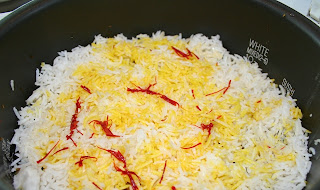Happy Lunar New Year! The Year of the Dragon! This weekend, if you are roaming around China town, Vietnamese town, Thai town, etc. you will see a lot of Pomelos, Kumquats, Oranges, and Tangerines. When I start seeing pomelos in Asian markets, I know that it is close to Tết (lunar new year). Then, I start thinking about making pomelo salad. If there is no pomelo in your area, you can use grapefruit instead. Pomelo is larger than grapefruit, can weight from 2-4 lbs, but it is not as tart as grapefruit. The fruit looks like this:
It is huge and has a very thick skin, about 1/2 to 1 inch thick. Here are videos I found in youtube: How to Cut, Peel, and Eat Pomelo (including the horror movie music background) and Peeling the Pomelo. For this salad, I shredded the pomelo sections/pulps after they are peeled (the white skin part was removed). The inside of my pomelo was white instead of pink such as it was in the videos.
Now, why should I make a salad dish in winter time? This should be a summer dish, right? We should all be eating soups, right? The reason is that citrus is in season now and it contains a lot of vitamin C, such as the pomelo above. It is time to eat CITRUS so we can fight colds that are common during winter. I also have a lot of fresh limes from my tree. I will need fresh limes for my pomelo salad. Pomelo and lime contain a double dose of vitamin C. This diet works since I am proud to say that I haven't had any cold in more than 1 year now. Actually, I don't remember the last time I had any cold.
The ingredients of pomelo salad are:
 |
| From top left, clockwise: shredded pomelo(in blue bowl), carrots, cucumber, aburaage, mint leaves, cilantro leave, beansprouts. |
Serve 4-6
2-3 cups shredded pomelo or grapefruit (it depends on the size of the pomelo, it can be from 1 to 2 pomelos after it is cut and peeled)
2 cups carrots, cut into matchsticks
2 cups cucumber, cut into matchsticks
1 cup aburaage or firm tofu, cut into matchsticks
Note: I used seasoned aburaage (one for inari) but you can use unseasoned aburaage or shredded fried tofu
2 cups beansprouts
1/4 cup chopped fresh mint leaves
1/4 cup chopped cilantro leaves
1/2 cup chopped roasted peanuts, 1-2 tablespoons more for the toppings
1/4 cup fried shallots, optional
Note: Below is the picture of fried shallots I bought at an Asian market. It is crunchy and savory. If you can't find it, you can substitute with French's French Fried Onions but fried shallots are the preference.
Salad dressing:
1/3 cup fresh squeezed lime juice (from 3-4 limes)
1/3 cup vegetarian soy sauce or light soy sauce
1/4 to 1/3 cup agave nectar, depending how sweet you like it
1 Tbsp. minced garlic
1 minced serrano chili or Thai chili
Note : for less spicy, use 1/2 chili
- Combine the salad ingredients in a large bowl. Don't mix the dressing until about ready to serve. Note: I often store the combined salad ingredients in the fridge without the dressing and add the dressing before serving.
- Combine the salad dressing in a separate bowl, mix well.
- Pour salad dressing slowly into the salad and toss well. Add chopped peanuts on top. Serve.



















